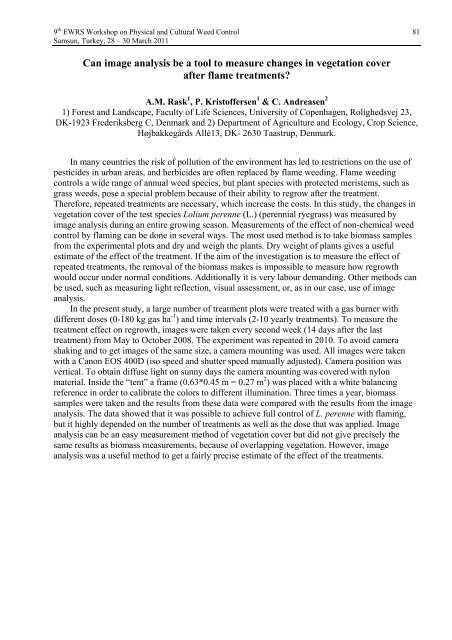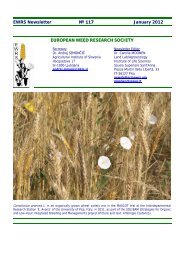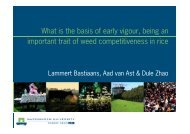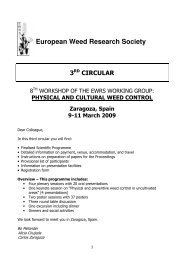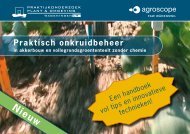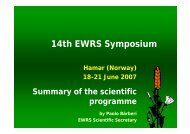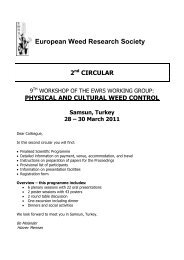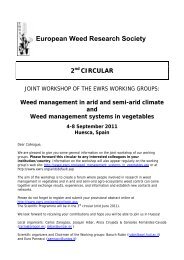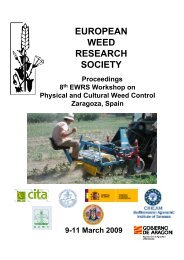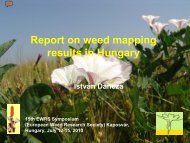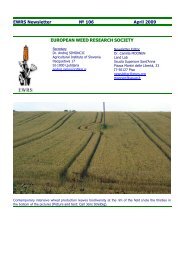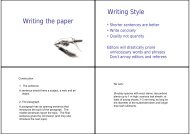Physical and Cultural Weed Control Working Group of - European ...
Physical and Cultural Weed Control Working Group of - European ...
Physical and Cultural Weed Control Working Group of - European ...
Create successful ePaper yourself
Turn your PDF publications into a flip-book with our unique Google optimized e-Paper software.
9 th EWRS Workshop on <strong>Physical</strong> <strong>and</strong> <strong>Cultural</strong> <strong>Weed</strong> <strong>Control</strong> 81<br />
Samsun, Turkey, 28 – 30 March 2011<br />
Can image analysis be a tool to measure changes in vegetation cover<br />
after flame treatments?<br />
A.M. Rask 1 , P. Krist<strong>of</strong>fersen 1 & C. Andreasen 2<br />
1) Forest <strong>and</strong> L<strong>and</strong>scape, Faculty <strong>of</strong> Life Sciences, University <strong>of</strong> Copenhagen, Rolighedsvej 23,<br />
DK-1923 Frederiksberg C, Denmark <strong>and</strong> 2) Department <strong>of</strong> Agriculture <strong>and</strong> Ecology, Crop Science,<br />
Højbakkegårds Allé13, DK- 2630 Taastrup, Denmark.<br />
In many countries the risk <strong>of</strong> pollution <strong>of</strong> the environment has led to restrictions on the use <strong>of</strong><br />
pesticides in urban areas, <strong>and</strong> herbicides are <strong>of</strong>ten replaced by flame weeding. Flame weeding<br />
controls a wide range <strong>of</strong> annual weed species, but plant species with protected meristems, such as<br />
grass weeds, pose a special problem because <strong>of</strong> their ability to regrow after the treatment.<br />
Therefore, repeated treatments are necessary, which increase the costs. In this study, the changes in<br />
vegetation cover <strong>of</strong> the test species Lolium perenne (L.) (perennial ryegrass) was measured by<br />
image analysis during an entire growing season. Measurements <strong>of</strong> the effect <strong>of</strong> non-chemical weed<br />
control by flaming can be done in several ways. The most used method is to take biomass samples<br />
from the experimental plots <strong>and</strong> dry <strong>and</strong> weigh the plants. Dry weight <strong>of</strong> plants gives a useful<br />
estimate <strong>of</strong> the effect <strong>of</strong> the treatment. If the aim <strong>of</strong> the investigation is to measure the effect <strong>of</strong><br />
repeated treatments, the removal <strong>of</strong> the biomass makes is impossible to measure how regrowth<br />
would occur under normal conditions. Additionally it is very labour dem<strong>and</strong>ing. Other methods can<br />
be used, such as measuring light reflection, visual assessment, or, as in our case, use <strong>of</strong> image<br />
analysis.<br />
In the present study, a large number <strong>of</strong> treatment plots were treated with a gas burner with<br />
different doses (0-180 kg gas ha -1 ) <strong>and</strong> time intervals (2-10 yearly treatments). To measure the<br />
treatment effect on regrowth, images were taken every second week (14 days after the last<br />
treatment) from May to October 2008. The experiment was repeated in 2010. To avoid camera<br />
shaking <strong>and</strong> to get images <strong>of</strong> the same size, a camera mounting was used. All images were taken<br />
with a Canon EOS 400D (iso speed <strong>and</strong> shutter speed manually adjusted). Camera position was<br />
vertical. To obtain diffuse light on sunny days the camera mounting was covered with nylon<br />
material. Inside the “tent” a frame (0.63*0.45 m = 0.27 m 2 ) was placed with a white balancing<br />
reference in order to calibrate the colors to different illumination. Three times a year, biomass<br />
samples were taken <strong>and</strong> the results from these data were compared with the results from the image<br />
analysis. The data showed that it was possible to achieve full control <strong>of</strong> L. perenne with flaming,<br />
but it highly depended on the number <strong>of</strong> treatments as well as the dose that was applied. Image<br />
analysis can be an easy measurement method <strong>of</strong> vegetation cover but did not give precisely the<br />
same results as biomass measurements, because <strong>of</strong> overlapping vegetation. However, image<br />
analysis was a useful method to get a fairly precise estimate <strong>of</strong> the effect <strong>of</strong> the treatments.


